
Organizing Food at Sea Menu: 1 2 3 4 5 6 7 8 9 10 11 12 13 14 15 16 17 18 Next>>
Organization of Ship's Food In the Golden Age of Piracy, Page 3
Naval Victualling Procedures Overview, Continued
"Through its centralised purchasing and manufacture, the Victualling Board became the country's first mass caterer, an onerous responsibility where any failure could have led to tragic consequences, but one that was on the whole discharged with considerable credit. Aware that the health, happiness and morale of crews depended in large part on their diet, the Admiralty early on insisted that the best-quality provisions should be supplied, and the Victualling Board constantly strove to improve the manufacturing processes and experiment with new foods and methods of preservation." (J. D. Davies, Pepys's Navy, 2008, p. 299)
Establishing the Victualling Commission (1683)
"All in all, the rise of the victualling department may have had more impact on the success of British arms than any other administrative development since the time of Pepys." (Daniel A Baugh, Naval Administration 1715-1750, 1977, p. 406)
The Victualling Commission was established in late 1683 in an effort to improve the efficiency of the food quality, supply,

Artist: Peter Lely - Charles II of England (1675)
and purchasing processes. The commission remained in charge of victualling until 1832, although our interest here only extends to the end of the Golden Age of Piracy (GAoP) in 1725.
The Commission was created by King Charles II, who the Lords of Treasury informed the Admiralty Commissioners "had been pleased to declare that he will take the management of the victualling of the navy into his own hands."1 A royal warrant issued on November 21st of that year appointed Richard Haddock, Anthony Stuart, John Parsons and Nicholas Fenn to be the first naval victualling commissioners. The King's commission explained
that it will be more conducible to our service, as well in lessening the charge of the victualling, as in furnishing the same at all times with good and wholesome provisions, to have the affair of the said victualling managed by commissioners to act wholly on our behalf and for the benefit of us as also of the seamen, soldiers and others from time to time serving us in our navy than by contractors at constant limited rates and prices as hath usually been done.2
The Board was established independent of the Navy Board because it was felt that victualling was too large a task to add to the Navy Board's many responsibilites.3 They met in the offices located at the London Tower Hill victualling yard and, in the beginning, met daily including Saturdays and Sundays.4 The board's function was spelled out in a document titled Victualling Instructions. This document was revised in 1690, 1697, 1700/1, 1711 and 1714.5 Copies of the 1690 instructions and 1697 instructions are publicly available and can be viewed via these links. The first seventeen articles found in these instructions are nearly identical, although the 1697 instructions easier to read. Relevant sections of the 1697 instructions are incorporated into this article.
From the beginning,
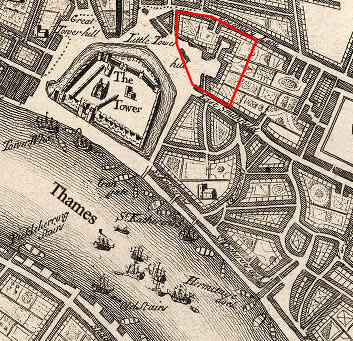
Cartographer: John Senex
Tower Hill Victualling Yard Approximate Location, London (1721)
the Board had several functions. The first was to buy materials needed for the sailors including food, food containers, coal (for heat), candles and stationery. The second function was to supervise everyone associated with victualling, both at the central Tower Hill location and at the local and foreign outports. In addition, they inspected the London and outport yards, examined victuals said to be bad, corresponded with ship's pursers in charge of food on navy vessels and were responsible for maintaining order at victualling sites and on navy ships as much as possible.
Their third function was to oversee the issuance of victuals to navy ships, which "was done only on warrants from 'the Lord High Admiral, or of three or more of the commissioners of the navy or the commander-in-chief of a fleet or squadron."6 Provisions were issued to all ships based on their destination; those working around England being typically provided with victuals for three to four months, while ships headed overseas were given the food required for six months.7 Any food supplied for a period beyond six months was agreed to become too deteriorated to be edible by the time it was used.
The Victualling Board's fourth function was to calculate the victualling needs for the upcoming year.8 The quantities were then provided to naval victuallers so they could procure and set aside required amounts of each foodstuff. In years when England was at peace, determining the next years' needs was straightforward because it didn't change much from year to year, allowing for accurate estimations. When England was at war, however, these numbers fluctuated wildly, making accurate prediction much more difficult.
To prevent institutional fraud, the commissioners were
not [in] any manner of way to be interested or concerned in selling of victuals, or any other stores, necessaries, or utensils whatsoever for the service of the victualling, or in and benefit or advantage which may arrive thereby, [managing the process] with all possible good husbandry for the king. ...[They were also to] take care that their cashier be the treasurer of the navy's instrument, and such a person as he will be responsible for,
Artist: Lady Jane Lindsay
Examining Documents in 1694 (1905)
and likewise that he reside at the victualling office on Tower Hill, there to issue out the moneys for the services aforesaid on behalf of the said trade.9
In an effort to monitor their actions, the Victualling Commissioners were required to present an annual account of naval victualling for the preceding fiscal year in March. "If we may infer anything from the silence of the Admiralty Letters, this change of method resulted in an improvement in the victualling of the navy. A few complaints were made in 1685, but an inquiry was ordered in each case by the navy board, and on the whole the victualling office did not come out badly under the test of mobilisation in 1688."10
The driving force behind the creation of the Victualling Board was, as the king put it, 'lessening the charge of the victualling'. In this effort, the navy would have preferred to do as much of the food processing as possible, but some of it was still performed by contractors until well beyond the end of the GAoP.
When dealing with contractors, the Board used a competitive system to reduce costs. For some items, they requested quotes for specified quantities from multiple victuallers, with delivery required within a few weeks. For other items such as meat, cheese and butter, longer-term contracts were used. Such contracts often wound up in the hands of the same victuallers for an extended period. Even so, the contracts were competitively bid each year. Being so unpredictable, wartime victualling contracts were generally given to fewer victuallers, probably because a reliable supplier was worth more than a slightly lower price.11
Even when the navy purchased food from such vendors, it still had to be processed at Tower Hill, which meant navy-owned space and facilities were needed.12 The Victualling Board established processing facilities that were either owned or leased by the navy for brewing beer, baking biscuit, slaughtering and salting meat.13 In addition to obtaining food for the navy, the board was also responsible for making sure it was "packed in suitable casks and some, such as beer, bread and meat, needed special processing."14 Facilities were established in the Tower Hill yard in London along with a cooperage for constructing casks. Unfortunately, these facilities weren't enough to completely supply the navy, particularly when England was at war, resulting in increased reliance on contracted victualling.
1 Cited in Paula K. Watson, "The Commission for Victualling the Navy, the Commission for Sick and Wounded Seamen and the Prisoners of War and the Commission for Transport, 1702–1714," University of London PhD thesis, 1965, p. 68; 2 Cited in Watson, p. 68-9; 3 Watson, p. 46; 4 Roger Morriss, The Foundations of British Maritime Ascendancy, Resources, Logistics and State, 1755-1815, 2011, p. 278; 4 Watson, p. 46, J. R. Tanner, 'The Victualling Instructions of 1697', The Mariner's Mirror, 1:2, (1911), p. 52 & House of Commons, Parliamentary Papers, Vol. 46, 1914, p. 228; 6 Watson, p. 71-2; 7 Janet MacDonald, Feeding Nelsons Navy, 2014, p. 58; 8 Morriss, p. 279; 9,10 J. R. Tanner, A Descriptive Catalogue of the Naval Manuscripts in the Pepsyian Library, 1903, p. 180-1; 11 Morriss, p. 287-8; 12 MacDonald,p. 52; 13 For examples, see Watson, p. 88, Michael Oppenheim, A History of the Administration of the Royal Navy, Vol 1, 1896, p. 40, "1700 - Victualling the Fleet," Historic England Website, gathered 11/2/2, & Morriss, p. 282; 14 Watson, p. 69
Victualling Commission Fits and Starts (1684-1701)
"You are doing a very good work in getting a strict account of the state of your victualls. Pray be pleased to hasten it. For notwithstanding all my pressing for the provideing of more, the service may meet with disappointment therein if the Commissioners of the Victualling here goe by one reckoning and the men eat by another." (Samuel Pepys, The Manuscripts of the Earl of Dartmouth, 1887, p. 218)
The Victualling Commission oversaw naval victualling throughout the entirety of the GAoP and well beyond it. However, the first 18 years were marked by organizational chaos. As a result, the composition of the board changed several times during this period and procedures were revised as various problems were encountered.

Photo: Mike Quinn
A Victualling Emblem on the Ornamental Gate of
the Steps
Leading to the Thames
Historian Christian Buchet explains, "due to a long list of negative factors such as lack of experience; the need to rethink and rework a whole new system and the deplorable state of the economy following the Revolution in 1688 [which deposed James II], it is hardly surprising that the early Commissioners failed in their task."1 With the onset of the War of the League of Augsburg in 1689, the Victualing Board found themselves just as incapable of supplying the fleet as private victualler Denis Gauden had at the beginning of the second Dutch War in 1665. The sudden increase in men at sea made it challenging to obtain sufficient quantities of any provisions, let alone good ones.
The Admiralty normally declared how many sailors would be victualled in the navy at Michaelmas (September 29) every year. "Any unforeseen change in the number [of sailors] declared caused great difficulty: for instance in 1703, when a projected expedition to the West Indies was cancelled, [it left] the Victuallers with a surplus of perishable stores to be disposed of at a loss."2 Sudden surges in the number of sailors during wars, combined with difficulty in finding qualified men to serve at sea made accurately predicting the number of sailors the next year very challenging, creating unexpected victualling surpluses and shortages.
As a result of their difficulty in supplying sufficient and sound provisions, the Board was called before the House of Commons. Unable to explain their inability to respond to the victualling needs to the satisfaction of the House, the contracts of Victualling Board members Haddock, Stuart, Parsons and Fenn were terminated. In their places, five new commissioners were appointed: James How, John Agar, Humphrey Ayles, Simon Mayne and Thomas Papillon.3
In addition, the Victualling Instructions were re-issued in 1690 with some additions. New Clause XVIII required the board to keep a monthly account of their stores, "expressing, in distinct Columns, the Time when, by whom, and Place where received, the Quality and Quantity of Provisions bought, with the Rate and Value paid, or to be paid, for the same."4 A tally was to be made of what was in stock at each naval victualling port and a copy was sent to the Comptroller of his Majesty's Victualling-Accounts in London.
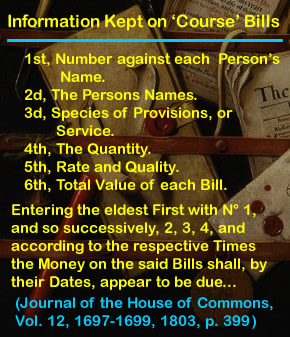
Information Recorded on the Bills in the 'Course'
Background Image Artist: Edward Collier
Trompe l'oeil with writing materials (ca 1702)
In attempt to solve the money problem, payment 'in Course' appears to have begun at this time.5 The word 'course' refers to paying vendors by credit, in order of receipt. Bills were "assigned upon [by] the Treasurer of the Navy for Payment in Course [order], according to their respective Numbers, out of such Monies or Funds as shall, from time to time, be appointed for the Service of the Victualling"6. The information included in these bills is shown in the graphic at left. 'Course' payments were only used for goods purchased by annual agreements (butter and cheese) and materials bought in the months following the annual harvest in England (grains, flour, and biscuit). Victuallers demanded cash where they could (beef and pork as well as grains and biscuit bought late in the harvest year.)7
These changes didn't really solve the problem of poor payment by the navy. As a result, the new victualling commissioners' success wasn't much better than their predecessors. The Victualling Board continued operating with insufficient funds to pay "huge bills, which, in turn, were a result of war-time requirements for a rapidly expanding fleet, and the vicious circle represented by delays in payment, prolonged credit and enhanced prices."8
The commissioners "were forced to operate speculatively, case by case, thus over the years destroying any semblance of organisation that the state had hoped to introduce."9 The inability to pay victualling contracts except by begging victuallers to accept the navy's unreliable credit made it impossible to solicit competitive bids, let alone make sure that supply was reliable. By 1690, the 'course' payments were a year behind. A financial
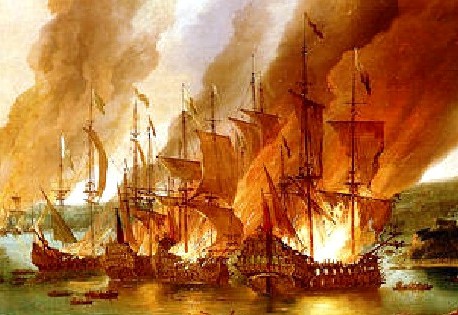
Photo: Adriaen van Diest - Battle of La Hogue during the Nine Years War (17th - 18th c.)
crises between 1695 and 1698 caused by the ongoing War of the League of Augsburg exacerbated this, forcing the Board to accept orders on unfavorable terms. Payment problems were so damaging to naval victualling reputation that the navy began paying the 'course' bills within two months of their due date in October of 1699. This helped restore the navy's credit with their contracted victuallers.10Although the navy's credit reputation improved with current victualling contractors by paying recent bills, it definitely didn't solve the problem. Some older bills remained unpaid for decades.
Food quality problems also continued during the war, likely due in part to the prices the navy was paying the victuallers. The cost to victual each sailor for a month at this time was estimated at 19 or 20 shillings by the navy, but the actual cost was closer to 23. Fortunately, the cost of victualling remained fairly constant throughout the golden age of piracy with the exception of the late 1690s and the years 1708 through 1710 when bad harvests caused the price of some foods to increase. During these brief period, the cost of victualling per man per month increased to about 30s. per man.11 Forced to buy at such high prices without an increase in their stipends, victuallers likely resorted to cheaper quality materials.
Baker John Kelly noted that some of the contract bakers were "mixing Meal made of Rye,
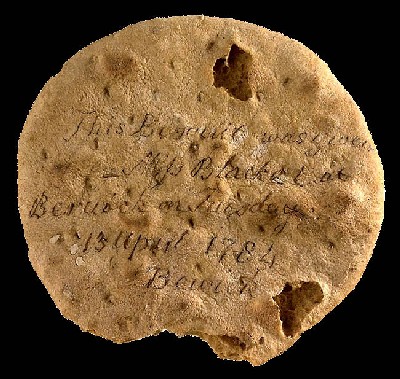
Existing Piece of Ship's Biscuit from 1784
Barly and Pease into their biscuit mix" and bribing officials to look the other way.12 Such additives caused the biscuit to break down faster at sea. to remedy this, he advised having the King's mills prepare the meal for them so that they could not adulterate it.
Poor payment and quality weren't the only problems with victualling at this time. Baker Kelly was hired by the Board "to regulate their own Bakehouse, and to see the Bakers abroad perform'd their part"13. Kelly pointed to several problems related to the timely supply of biscuit for the navy during the war. He suggested "how they might raise more Bread in the Office, and my House [referring to Kelly's bakery], by setting the Ovens to work Night-work, which he acquainted the [Victualling] Commissioners with; upon which I was sent for to the Board, and was order'd to do as I proposed"14.
In an effort to increase supply as well as have more control over it, Kelly advised the Committee to purchase the Miller's biscuit mills located at Rotherhithe, something the Lords of Admiralty approved. "We think Mr. Kelly therein did a good Service"15. Much of Kelly's work in this realm was somewhat self-serving. The fact that he published the details of what happened and wrote about them in a way to make himself look good testify to this. Yet, he did provide insight into problems with the supply of at least one necessary naval provision at the end of the seventeenth century. Taking his advice about the Rotherhithe mills also hints at the Victualling Committees' interest in bringing more of the food processing into the navy facilities.
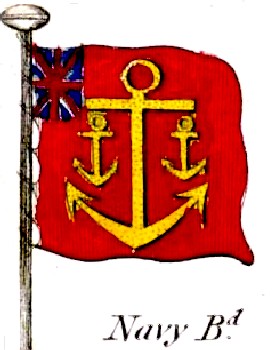
Navy Board Flag, From Plates Descriptive of the
Maritime
Flags of All Nations, By John William Norrie (1832)
In an effort to improve the the victualling process, new Victualling Instructions were again issued in January of 1701 which set rules which those involved in the victualling victualling process were expected to follow. The goals of these rules included:
- Creating a new 'course' of payments to prevent mismanagement of the victualler's accounts.
- Putting the Victualling Board under the control of the Navy Board so that the victuallers were part of the navy hierarchy.
- Creating uniformity across procedures used by the various naval departments.16
The same was done with the Sick and Wounded Board and Transport Boards, with the Navy Board working most closely with the admiralty, relaying information between them and these now subordinate boards.17
The Navy Board was put in charge of examining the accounts of the other boards. This improved organization through the use of more consistent procedures throughout the navy. As a result, the Victualling Board was required to submit their accounts to the comptroller of victualling, one of the naval commissioners, or to the whole board. The new rules reiterated the menu for navy vessels, remaining largely relying on the diet set forth under Pepys' 1677 victualling contract. "The points of difference are that pork, instead of being an alternative to beef two days a week, was now a regular issue on those two days, except in June, July, and August, when beef would be substituted. Oatmeal might be issued instead of fish, but was disliked by the men, probably because it quickly bred maggots."18
1 Christian Buchet, The British Navy, Economy and Society in the Seven Years War, 2013, Translated Anita Higge and Michael Duffy, p. 17; 2 Commander R. D. Merriman, Queen Anne's Navy, 1961, p. 252; 3 Isaac Schomberg, Naval Chronology, Vol V, p. 209; 4 His Majesty's Stationery Office, Journal of the House of Commons, Vol. 12, 1697-1699, 1803, p. 399; 5 His Majesty's Stationery Office, Calendar of Treasury Books, Vol. 9, 1689-1692, 1931, p. 427; 6 Journal of the House of Commons: Vol. 12, p. 399; 7 Paula K. Watson, "The Commission for Victualling the Navy, the Commission for Sick and Wounded Seamen and the Prisoners of War and the Commission for Transport, 1702–1714," University of London PhD thesis, 1965, p. 149; 8 R.D. Merriman, The Sergison Papers, (Naval Clerk of Acts), 1950, p. 235; 9 Buchet, p. 18; 10 Watson, p. 149; 11 Daniel A Baugh, Naval Administration 1715-1750, 1977, p. 405 & N. A. M. Rodger, The Command of the Ocean, A Naval History of Britain, 2006, p. 193 - Note that Rodger says the cost per man per month increased during poor harvests; Baugh suggests that the increases in some provisions' costs were offset by decreases in prices of other provisions; 12 John Kelly, An impartial relation of John Kellys Services in the Victualling Office, 1699, p. 1; 13,14 Kelly, p. 3; 15 "Commissioners Report to the Lords of Admiralty", Cited in Kelly, p. 9; 16 Watson, pp. 148 & 150; 17 Watson, p. 44; 18 Merriman, pp. 249-50


